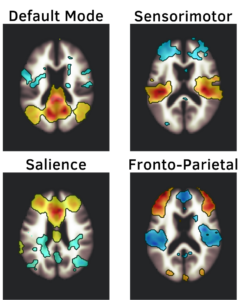
Concussions are among the most common childhood injuries and have traditionally been difficult to manage and treat. Until recently, the medical advice given to children after a concussion was to rest until they no longer had any symptoms. Challenging this status quo, scientists have now shown that participating in exercise or light activity soon after a concussion can improve concussion symptoms. But we do not yet know if and how exercise impacts the brain after a concussion. We need to understand this as, after all, concussions are brain injuries.
The goal of the ConExNet study is to understand the effect of exercise on brain activity following concussion in children. For example, the picture above shows different ‘brain networks’, or patterns of activity we expect to see in most people when we scan their brain with a special type of MRI. We want to understand if exercise changes these brain networks in children with a concussion differently than in children who have not had a concussion. In doing so, we will be able to better and more completely understand the role of exercise in concussion recovery, and help children with concussion return to their normal activities sooner.
To do this, we are going to answer the following questions:
- How does exercise impact brain activity (or brain networks) in children with concussion compared to their healthy peers?
- Is brain function related to the number and severity of concussion symptoms?
- Does the amount and type of activity performed soon after a concussion impact brain function and/or the number and severity of concussion symptoms?
What does this study involve?
This study involves two visits that are separated by approximately 48 hours. The first visit involves completing a 15-minute exercise test on a treadmill. Before and after this test, participants will be asked to complete a set of brief questionnaires as well as a 5-minute balance test. The second visit takes place at the Imaging Research Centre at St. Joseph’s Healthcare Hamilton. This visit involves an initial 30-minute MRI, 10-minutes of exercise on a treadmill, and then another 20-minute MRI. Afterwards, participants will be asked to wear a small device called an accelerometer to measure their physical activity over the next month, as well as complete a brief, online concussion symptom survey every day.
Who is eligible to participate?
Our participants are boys and girls between the ages of 12 and 18. We are recruiting both children with a recent sport-related concussion as well as children with no history of concussion. Children with concussion must be cleared to exercise by our clinical collaborator. Note: children with braces cannot participate in the study, as these cause interference with the MRI; wire retainers are okay.
Who do I contact if I want to learn more?
If you have questions or want to learn more about this study, please contact Dr. Bhanu Sharma by e-mail at sharmb1@mcmaster.ca.
The ConExNet study is funded by the Canadian Institutes of Health Research (CIHR).

